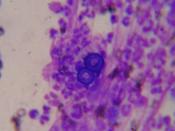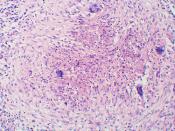BLASTOMYCOSIS
Kingdom: Fungi
Phylum: Ascomycota
Class: Euascomycetes
Order: Onygenales
Family: Onygenaceae
Genus: Blastomyces (Blastomyces dermatitidis is the only species included in this genus.)
Blastomycosis, also called Gilchrist's Disease, is caused by Blastomyces dermatitidis. This fungus is thermally dimorphic and a probable saprobe of the soil. It specifically inhabits decaying wood material, animal feces, plant fragments, and insect remains. Soil with an acidic pH and a high organic content is conducive to growth. At room temperature and in its natural site in soil, it grows as a mold. However, when the spores are inhaled and environmental temperature is elevated , B. dermatitidis conidia convert into invasive large yeasts.
While this is not a common disease, it does occur sporadically in the US. In the U.S.A., the endemic area for blastomycosis includes the Ohio, Missouri, and Mississippi river valleys and Midwestern states bordering the Great Lakes. There are estimated 1-2 cases per 100,000 people in these endemic areas, which all have close proximity to waterways.
Although a review of death records for 2002 indicated blastomycosis was the reported underlying cause of death for 44 persons in the United States, epidemiologic patterns for this disease have not been fully characterized because blastomycosis is not nationally notifiable. It is a reportable disease only in Wisconsin and small, local areas of other states. According to the CDC, there is a 5% mortality rate. African-type B. dermatitidis strains isolated from cases in Africa also exist. It was demonstrated that the African-type strains are not identical to the North American strains.
The disease is transmitted by inhaling spore-laden dust. Person-to-person transmission does not occur. It is more common in men who work in outdoor occupations (construction, farming, etc.) Analysis of information regarding sporadic case reports suggests the risk for disease may be greater among...


